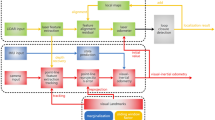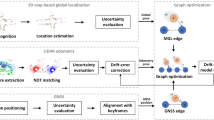Abstract
Accurately localizing the vehicle against a pre-built high precision map is an essential step for the Autonomous Land Vehicle (ALV). This paper proposes an efficient scan-to-map matching approach based on multi-channel lidar. We firstly advocate the usage of both the lidar reflectance map and the height map, as these two maps contain complementary information. Then, borrowing ideas from the Lucas-Kanade optical flow approach, we formulate the scan-to-map matching problem in a similar form, and propose an efficient gradient descent approach to solve it. Finally, the proposed approach is integrated into a filtering framework for real-time online localization. Experiments on real-world dataset have demonstrated the validity of our approach.
Similar content being viewed by others
Explore related subjects
Discover the latest articles, news and stories from top researchers in related subjects.References
Arun, K.S., Huang, T.S., Blostein, S.D.: Least-squares fitting of two 3-D point sets. IEEE Trans. Pattern Anal. Mach. Intell. 9, 698–700 (1987)
Baker, S., Matthews, I.: Lucas-Kanade 20 Years On: A Unifying Framework. Int. J. Comput. Vis. 56(3), 221–255 (2004)
Besl, P.J., McKay, H.D.: A method for registration of 3-D shapes. IEEE Trans. Pattern Anal. Mach. Intell. 14(2), 239–256 (1992)
Biber, P., Straßer, W.: The normal distributions transform: A new approach to laser scan matching. In: International conference on intelligent robots and systems, pp. 2743–2748 (2003)
Chen, T., Dai, B., Daxue, L., Wang, R.: Gaussian-Process-Based Real-Time Ground Segmentation for Autonomous Land Vehicles. J. Intell. Robot. Syst. 76(3-4), 563–582 (2013)
Douillard, B., Quadros, A., Morton, P., Underwood, J.P., De Deuge, M., Hugosson, S., Hallstrom, M., Bailey, T.: Scan segments matching for pairwise 3D alignment. In: IEEE international conference on robotics and automation, pp. 3033–3040 (2012)
Fabbri, R., Costa, L.D.F., Torelli, J.C., Bruno, O.M.: 2D Euclidean distance transform algorithms. ACM Comput. Surv. 40(1), 1–44 (2008)
Gindele, T., Brechtel, S., Schrȯder, J., Dillmann, R.: Bayesian Occupancy Grid Filter for Dynamic Environments Using Prior Map Knowledge. In: Intelligent vehicles symposium (IV), pp. 669–676 (2009)
Grisetti, G., Stachniss, C., Burgard, W.: Improved techniques for grid mapping with Rao-Blackwellized particle filters. IEEE Trans. Robot. 23(1), 34–46 (2007)
Hartley, R., Zisserman, A.: Multiple View Geometry in Computer Vision, 2nd edn. Cambridge University Press, Cambridge (2004)
Kaess, M.: Student Member, and Ananth, Ranganathan. iSAM: incremental smoothing and mapping. IEEE Trans. Robot. 24(6), 1365–1378 (2008)
Kohlbrecher, S., Von Stryk, O., Meyer, J., Klingauf, U.: A Flexible and Scalable SLAM System with Full 3D Motion Estimation. In: IEEE international symposium on safety, security and rescue robotics, pp. 155–160 (2011)
Levinson, J., Thrun, S.: Robust vehicle localization in urban environments using probabilistic maps. In: IEEE international conference on robotics and automation, pp. 4372–4378 (2010)
Lewis, J.P.: Fast Normalized Cross-Correlation. Vision Interface 10, 120–123 (1995)
Lucas, B.D., Kanade, T.: An iterative image registration technique with an application to stereo vision. In: Proceedings of the 7th international joint conference on artificial intelligence, pp. 674–679 (1987)
Maddern, W., Pascoe, G., Newman, P.: Leveraging Experience for Large-Scale LIDAR Localisation in Changing Cities. In: IEEE international conference on robotics and automation (2015)
Montemerlo, M., Roy, N., Thrun, S.: Perspectives on standarization in mobile robot programming: The carnegie mellon navigation (CARMEN) toolkit. In: International conference on intelligent robots and systems (IROS), vol. 3, pp. 2436–2441 (2003)
Olson, E.: Real-Time Correlative Scan Matching. In: Proceedings of the IEEE international conference on robotics and automation, pp. 4387–4393 (2009)
Olson, E., Strom, J., Goeddel, R.O.B., Morton, R., Ranganathan, P., Richardson, A.: Exploration and mapping with autonomous robot teams. Commun. ACM 56, 62–70 (2013)
Rainer, K., Grisetti, G., Strasdat, H., Konolige, K., Burgard, W.: g2o: A General Framework for Graph Optimization. In: ICRA, pp. 3607–3613 (2011)
Segal, A.V., Haehnel, D., Thrun, S.: Generalized-ICP, vol. 2, pp. 1–8 (2009)
Thrun, S.: A probabilistic on-line mapping algorithm for teams of mobile robots. Int. J. Robot. Res. 20, 335–363 (2001)
Thrun, S.: Learning occupancy grid maps with forward sensor models. Auton. Robot. 15(2), 111–127 (2003)
Wolcott, R.W., Eustice, R.M.: Visual localization within LIDAR maps for automated urban driving. In: IROS, pp. 176–183 (2014)
Wolcott, R.W., Eustice, R.M.: Fast LIDAR localization using multiresolution Gaussian mixture maps. In: 2015 IEEE international conference on robotics and automation (ICRA), pp. 2814–2821 (2015)
Ji, Z., Singh, S.: LOAM: Lidar Odometry and Mapping in Real-time. In: Robotics: Science and Systems, pp. 1–8 (2014)
Acknowledgements
This authors would like to thank the National Natural Science Foundation of China for the funding of Grant 61503400.
Author information
Authors and Affiliations
Corresponding author
Ethics declarations
I certify that this manuscript is original and has not been published and will not be submitted elsewhere for publication while being considered by Journal of Intelligent & Robotic Systems. The study is not split up into several parts to increase the quantity of submissions and submitted to various journals or to one journal over time. No data have been fabricated or manipulated (including images) to support the conclusions. No data, text, or theories by others are presented as if they were our own. The submission has been received explicitly from all co-authors. And authors whose names appear on the submission have contributed sufficiently to the scientific work and therefore share collective responsibility and accountability for the results.
Conflict of interests
The authors declare that they have no conflict of interest. This article does not contain any studies with human participants or animals performed by any of the authors. Informed consent was obtained from all individual participants included in the study.
Electronic supplementary material
Below is the link to the electronic supplementary material.
Rights and permissions
About this article
Cite this article
Fu, H., Yu, R., Ye, L. et al. An Efficient Scan-to-Map Matching Approach Based on Multi-channel Lidar. J Intell Robot Syst 91, 501–513 (2018). https://doi.org/10.1007/s10846-017-0717-0
Received:
Accepted:
Published:
Issue Date:
DOI: https://doi.org/10.1007/s10846-017-0717-0




